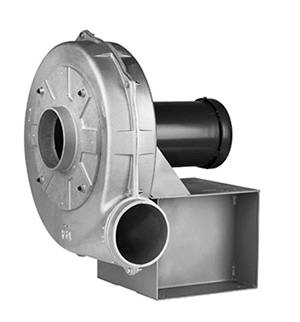Spark resistant explosion proof ventilator may be required in any area where the presence of flammable gases, vapors or finely pulverized dust in the atmosphere is sufficient to create a threat of an explosion or fire. It may also be required where easily ignitable fibers or flying's are present. The following information is a representative, but is not an all-inclusive, list of the types of locations and operations that require hazardous location air exhaust / ventilation equipment in at least certain areas. Consult the current National Electric Code® for complete and current information.
Tough applications mean tough fans and blowers by Canada Fan. Canada Fan Co. is a world wide distributor of industrial process ans OEM fans and blowers, as well as fan / blower components; including high pressure blowers, high temperature fans, spark resistant and explosion proof ventilators, tubeaxial and vaneaxial high pressure ventilators. Canada Blower also does existing fans and blowers repairs, re-build, as well as dynamical wheels balancing.
Typical Class I Locations Include:
• Petroleum refining facilities • Dip tanks containing flammable or combustible liquids • Dry cleaning plants • Organic coating manufacturing plants • Paint spray booths • Spray finishing areas (residue must be considered) • Petroleum dispensing areas • Solvent extraction plants • Plants manufacturing or using pyroxylin • (nitro-cellulose) type and other plastics • (Class II also) • Locations where inhalation anesthetics are used • Utility gas plants and operations involving storage and handling and liquefied petroleum and natural gas • Aircraft hangars and fuel servicing areas
Typical Class II Locations Include:
• Grain elevators and bulk handling facilities • Magnesium and aluminum powder manufacture and storage facilities • Starch manufacture and storage facilities • Fireworks manufacture and storage facilities • Flour and feed mills • Pulverized sugar and cocoa packaging and handling areas • Coal preparation and handling facilities • Spice grinding plants • Confectionery manufacturing plants
Typical Class III Locations Include:
• Woodworking plants • Textile mills • Cotton gins and cotton seed mills • Flax producing plants
Certain chemicals may have characteristics that require safeguards beyond those required for any of the certified atmospheric groups. Carbon disulfide is an example of such a chemical because of its low ignition temperature and the small joint clearance to arrest its flame propagation.
Some metal dust may have characteristics that require safeguards beyond those required for atmospheres containing the dust of aluminum, magnesium and their commercial alloys. For example, zirconium, thorium and uranium dust have extremely low ignition temperatures and minimal ignition energies lower than any material classified in any of the Class I or Class II groups.
The Hazardous Location fans incorporate spark proof construction in its design to minimize the potential for a random spark being the ignition source of an explosion in a hazardous location. All major components are fabricated from materials that will not produce a spark when struck by a direct impact blow i.e. aluminum propeller or blade and explosion proof motors.
As an illustrative example, consider the potential consequence if a tool is dropped and strikes the blade or propeller of an exhaust / ventilation fan in use. With in a non-hazardous atmosphere, the risk for an explosion is minimal. However, if the same tool strikes the exposed, steel surfaces of a fan operating in a hazardous location containing gasoline fumes, the results could be drastically different. The blow produced by the tool could create a random spark. In the case of gasoline fumes, the addition of a proper air and gasoline fume mixture could result in an explosion. Minimizing this potential for a spark ignition is also an important reason to use spark proof tools and related equipment in hazardous locations. By incorporating basic spark proof blade / motor construction, the potential for a spark-ignited explosion caused by a direct blow is greatly minimized. The use of an explosion proof motor alone, or an aluminum blade / propeller, does not qualify the fan as "explosive proof". At the same time no air exhaust / ventilation fan is totally explosion proof. Only a product utilizing proper design and certification standards can minimize the risk of an explosion in an applicable hazardous atmosphere.


